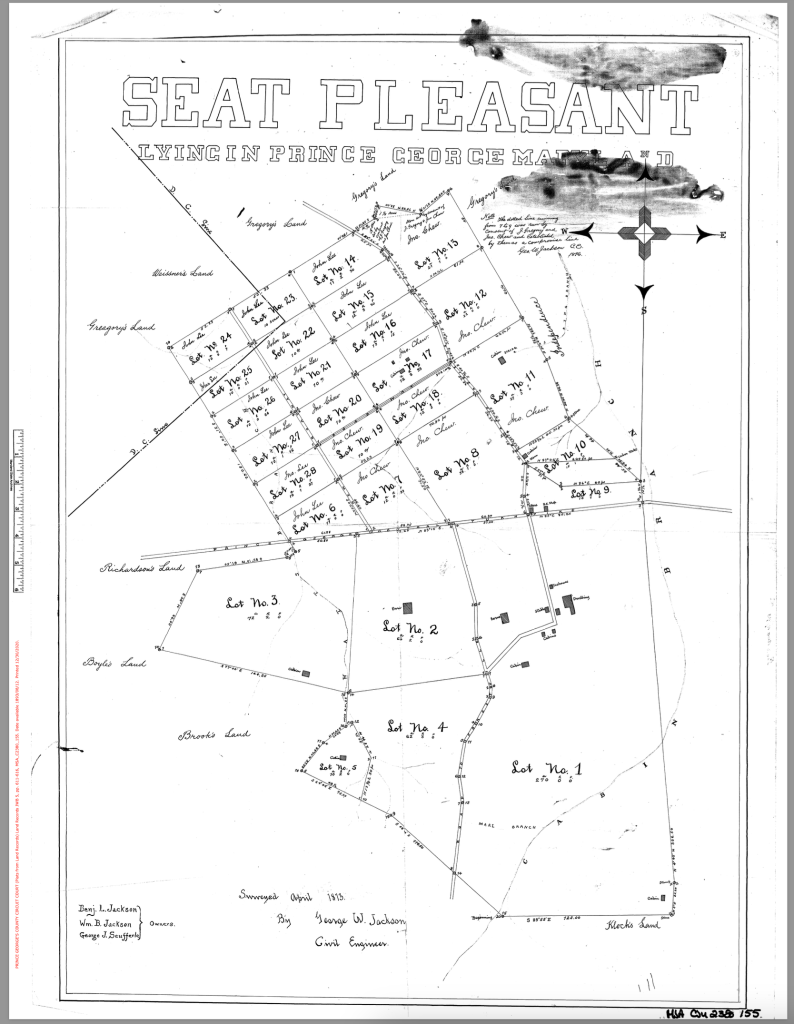See “the many Patrick Stewarts” for the introduction to why this post was written.
Patrick Stewart of the Marsham Waring Inventory was 40 years old with an estimated birth year of 1820. Patrick Stewart of Seat Pleasant was 37 in the 1870 census, with an estimated birth year of 1833. It seems unlikely that they are the same Patrick Stewart. And as Patrick Stewart of Seat Pleasant is followed through the census records, it becomes even more unlikely that he is the Patrick Stewart of the Marsham Waring Inventory. In 1880, he was listed at 40, which shifted his birth year from 1833, to 1840, two decades after the Patrick Stewart of the Inventory was born; the same for the 1900 census, where he was listed as 60, making his birth year around 1840.
After Emancipation
In the 1870 US Census, Patrick Stewart and his wife, Lidia, are living near John E. Berry, the son of Dr. John E Berry. They are near the intersection of what is now Addison Road and Central Avenue in Seat Pleasant.

In 1880, Patrick Stewart is still living in Kent, the district formed from Bladensburg. In his household is Patrick and Mary Stewart, an elderly couple. Patrick is listed as 70 years old and Mary is listed as 65. They are most likely his parents. Patrick is enumerated as Pat. Hen., which is consistent with the land record that is recorded in 1892.
Patrick Henry Stewart purchased Lot #5 of the Seat Pleasant subdivision. The land contained about 10.5 acres. He paid $350 for the lot. (JWB 22:262; mdlandrec.net)
The land was situated near the corner of DC in the portion of Bladensburg District which was used to create the Kent District in the 1870s. It sat on the former land of John E Berry, Jr., an enslaver and landowner in Prince George’s County prior to the Civil War. Berry, Jr., purchased “Seat Pleasant” from his relative Thomas E Berry. At the close of the Civil War, the land was sold to real estate developers who created the town of Seat Pleasant. Berry’s father, Dr. John E Berry, Sr., had a nearby plantation called Independence, and Berry’s brother, Albert B Berry had a farm called Sunnyside in addition to his other real estate holdings.


The survey of Seat Pleasant was completed in 1873. In addition to detailing the lots, it marks what is likely the Seat Pleasant dwelling house and marks several cabins on the land, which may have be slave dwellings occupied by freedmen after manumission.
A death certificate records Patrick Stewart’s death in May 1929, when he died from “entero-colitis”. It lists his occupation as farmer and at the time of his death, he was living in the District at 30 H Street NE, the household of John Thomas Stewart, his son. The death certificate also lists his parents as Patrick Stewart and Mary Ridout, names consistent with the 1880 census.

Before Emancipation
Prior to emancipation, Patrick (Henry) Stewart was enslaved by John E. Berry, who submitted a compensation list to the 1867 Commission on Slave Statistics; Berry was also the landowner of Seat Pleasant. Patrick (Henry) Stewart was listed as 20 years old, giving him an estimated birth year of 1845. Also enslaved by John E Berry is Mary Stewart (II), who was 38, born about 1827.
John E. Berry also submitted a list as administrator of the estate of Albert B Berry, his brother, who owned adjacent land. On the list submitted for A. B. Berry are Mary Stewart (I), age 58, and Alexander, age 22. Working from the assumption that Mary Stewart (I) is Mary Ridout, this allows us to expand the outline of the family. I wrote another detailed post about Mary Ridout and her connection with other Ridout Branches (and therefore the Stewart family).

In brief, Mary Ridout is likely related to Ridout Family Group enslaved by the Sprigg Family (Northhampton) and Waring Family. The Sprigg family enslaved Margaret (Brooks) Ridout who was the inferred mother of Barbara Ridout who married Joseph Jones, both enslaved by the Warings. Many of the Ridouts can be found in the vicinity of Seat Pleasant after emancipation. This suggests the likelihood that Mary Ridout was married to Patrick Stewart of the Waring estate.
Disambiguation
Patrick Henry Stewart of Seat Pleasant is too young to be Patrick Stewart of the Waring estate and he can be found in the compensation lists of John E Berry with other relatives. However, Patrick Henry Stewart is the son of Patrick Stewart of the Waring Inventory, as evidenced by the direct evidence of his death certificate which names his father and his mother’s family name. His mother’s family name, Ridout, provides indirect evidence that there were connection to the Stewart estate.










